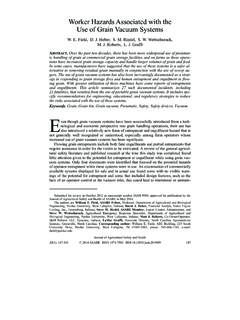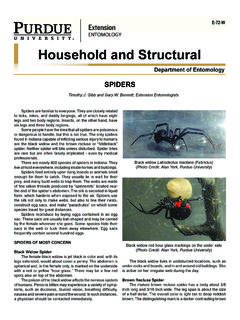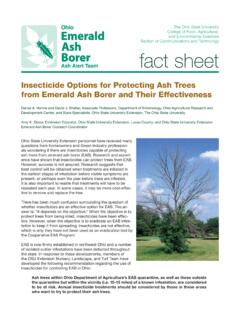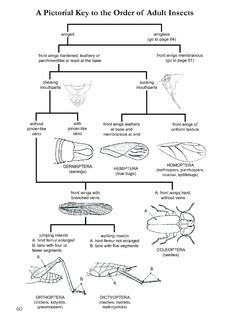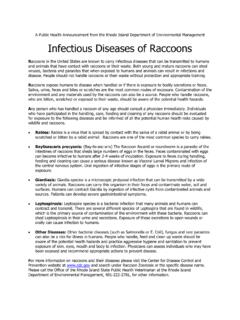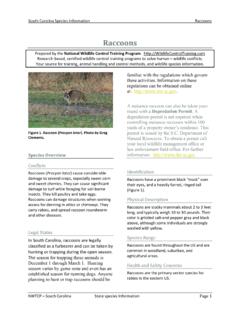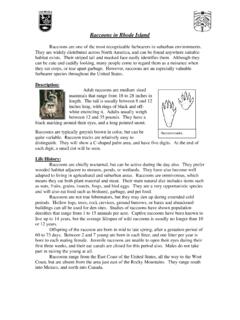Transcription of ADM-17-W Animal Damage Management - Purdue University
1 Purdue EXTENSION Animal Damage ManagementADM-17-W Department of Entomology PROTECTING YOURSELF FROM WILDLIFE DISEASES: RACCOON ROUNDWORM (Baylisascaris procyonis) Joe N. Caudell, Wildlife Biologist WHAT IS RACCOON ROUNDWORM Roundworms are parasitic organisms that live in the intes-tines of animals (including humans). The raccoon roundworm lives in the intestines of raccoons . The roundworm survives by feeding on nutrients that the raccoon has digested. The roundworm lays eggs (upwards of 100,000 per day) in the intestine of the raccoon, which are then shed through the raccoon s feces. A raccoon can shed millions of eggs per day, depending upon how many roundworms are present it its intestines. In general, raccoon roundworms do not harm the raccoon host, other than by using some of the nutrients that the raccoon has eaten.
2 Raccoon roundworm spreads to other animals when an Animal eats the feces of the raccoon, kills and eats a raccoon, or eats food items contaminated with raccoon feces. Many animals eat the feces of raccoons because they contain un-digested seeds, and thus inadvertently ingest the roundworm eggs. Once the eggs pass into the intestines, they hatch. The larva penetrates the lining of the intestines and migrates around inside the body of the host, resulting in a disease called visceral larval migrans. Figure 1. Life cycle of Baylisascaris infection (Drawing credit: Tammy Luck, Purdue University ) While raccoon roundworm sounds like a scary dis-ease, it is important to put it into perspective. During a 20-year period (from 1981 through 2002), there have been approximately 12 se-vere or fatal cases through-out the United States, in-cluding California, Illinois, Michigan, Minnesota, New York, Oregon, and Penn-sylvania.
3 Most of the cases have been found in small children ranging in age from 9 months to 6 years, prob-ably due to the fact that chil-dren of this age will put al-most anything they find into their mouths. Therefore, an important part of preventing this disease is cleaning rac-coon feces that children may have access to. Raccoon Roundworm ADM-17-W 2 These migrating larvae can cause serious problems in the host. Large numbers of larvae can Damage the liver, lungs, and other organs. Larvae are known to migrate into the ocular tissue and brain, causing numerous problems, including blindness, paralysis, unusual behavior, and death. Altered behaviors of infected animals may include inability to walk or climb, loss of fear (of humans or other animals), rolling on the ground, falling over, and other unusual actions.
4 Humans may develop lesions from larvae migrating in subcutaneous tissue or eye and brain tissue Damage . This can cause nausea, lethargy, loss of coordination, and blindness. Symptoms will typically appear one to three days after the initial infection; however, they may take longer. The onset of symptoms is related to several factors, such as the path of larval migrations and the number of eggs ingested. Currently, there is no effective treatment against a raccoon roundworm infection. The best way to stay healthy is to reduce or avoid contact with raccoons and raccoon feces. AVOIDING CONTACT WITH raccoons While raccoons can be interesting to observe, they can cause a significant amount of Damage in a short amount of time. So never attempt to raise raccoons as pets.
5 Even young raccoons can carry roundworm. Not only is it illegal in Indiana to keep raccoons as pets (without a permit), but your chances of becoming infected with roundworm or other dangerous diseases are greatly increased. The old saying An ounce of prevention is worth a pound of cure is very true when it comes to raccoons . The best way to protect yourself, family, pets, and livestock from raccoon roundworm is to reduce the amount of time raccoons spend on your property. And the best way to do that is to eliminate anything that attracts them, especially food. Remove any accidental food ( , dog food when it s not feeding time, excessive amounts of bird food, trash, etc.) and intentional food ( , food left outexpresslyfor raccoons ), and make sure that you have sturdy trash cans with lids that can be fastened securely.
6 For more details on raccoon behavior and preventing raccoon Damage , see the related Purdue University Extension publication on raccoons at <http://www. >. CLEANING RACCOON LATRINES Danger from raccoon roundworm increases when rac-coons stay long enough on your property to leave their feces. Because raccoon feces contain the roundworm eggs that can infect you, your family, and your pets, you need to know as much as possible about where raccoons defecate, what their feces look like, and how to clean the areas where they have defecated. raccoons have a tendency to defecate in specific areas called latrines. raccoons generally use flat, elevated sites ( , rooftops, attics, chimneys, decks, haylofts, wood piles, etc.) for latrines, but may also use the base of trees, buildings, flower beds, gardens, or other areas.
7 These latrines fill with piles of raccoon feces of different ages (dry on the bottom, becoming progressively fresher toward the top). Raccoon feces are about the diameter of a dime or nickel and are tubular with blunt ends. Old feces may look like dried leaves or other debris. It s important that you clean any raccoon latrines you find on your property, and it s equally important that you do so safely and effectively. Figure 2. Raccoon latrine on an elevated surface Figure 3. Raccoon feces on ground PROTECTING YOURSELF Raccoon roundworm eggs are approximately 65 microns in size, which is equivalent in size to sawdust, lint particles, and pollen. To avoid inhaling the eggs during cleaning, wear a dust mask that can filter out this size particle (also called an N95-rated mask).
8 These types dust masks are commonly available at hardware stores. Be sure to mold the mask to your face. It should fit snugly, without any gaps between your skin and the mask. In addition to a dust mask, use dispos-able gloves, rubber boots or disposable booties during the cleaning operation. Immediately wash the clothes you have worn during the cleaning procedure in very hot, soapy water, separate from other clothing. To further protect your clothing from possible contamination,wearinexpensive full-body,disposable overalls available at most paint or hardware stores. 3 Raccoon Roundworm ADM-17-W Misting dry feces lightly with water will help with dustcontrol and may also prevent the feces and the eggs from breaking up if scraping is required; however, do not soak or wet the feces heavily.
9 This will make the mess harder to clean up. Do not spray the feces with a disinfectant, such as a chlo-rine bleach, to try to kill the eggs. The eggs are resistant to most household disinfectants. The eggs are also coated with a sticky substance which allows them to adhere to the feces. Some disinfectants, such as chlorine bleach, can deactivate this sticky substance, possibly allowing the eggs to break free from the feces during cleaning operations. If you come into direct contact with raccoon feces: Be sure to keep you hands away from your face Wash your skin with plain soap and warm water Clean under your nails thoroughly with a brush Wash clothes separately in hot, soapy water Raccoon roundworm eggs take 14 to 28 days to become infective.
10 Therefore, clean up raccoon feces immediately whenever they are found. CLEANING INDOOR LATRINES If the latrine is in an attic and has contaminated insulation material, you will only need to remove the insulation material that is in contact with the feces. If your house has rolls or batts of insulation, cut enough of the contaminated insulation so you can simply roll it up and dispose of it into a heavy-duty garbage bag. If your house has blown-in insulation, mist the area to be removed with water for dust control, and carefully scoop up the contaminated insulation in to a heavy-duty gar-bage bag. Use a twist-tie to close the bag. Be careful when closing the back that the escaping air and dust from the bag does not blow into your face. Place the first bag into a second bag, and twist-tie it as well.
